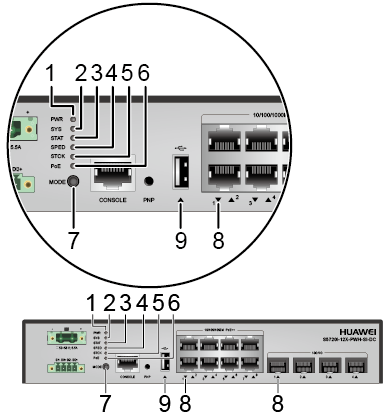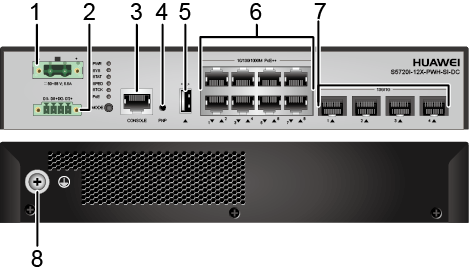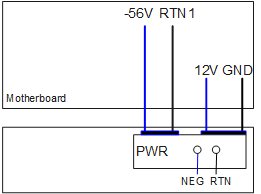S5720I-12X-PWH-SI-DC
Version Mapping
Table 1 lists the mapping between the S5720I-12X-PWH-SI-DC chassis and software versions.
Appearance and Structure
1 |
DC input power socket NOTE:
It must be used with the Phoenix connector, which is included in the installation accessory package. |
2 |
Monitoring port NOTE:
It must be used with the Phoenix connector, which is included in the installation accessory package. The monitoring port detects the status of external devices, for example, monitoring the opening and closing of the cabinet door. For details about how to use a monitoring port, see "Monitoring Interface Configuration" in the CLI-based Configuration Guide - Device Management Configuration Guide. |
3 |
One console port |
4 |
One PNP button NOTICE:
To restore the factory settings and reset the switch, hold down the button for at least 6 seconds. To reset the switch, press the button. Resetting the switch will cause service interruption. Exercise caution when you press the PNP button. |
5 |
One USB port |
6 |
Eight PoE++ 10/100/1000BASE-T ports |
7 |
Four 10GE SFP+ ports |
8 |
Ground screw NOTE:
It is used with a ground cable. |
Port Description
10/100/1000BASE-T port
Attribute |
Description |
|---|---|
Connector type |
RJ45 |
Standards compliance |
IEEE802.3, IEEE802.3u, IEEE802.3ab |
Working mode |
10/100/1000 Mbit/s auto-sensing |
Maximum transmission distance |
It supports long-distance interconnection with Huawei cameras.
For example, it supports the distance of 200 m at 100 Mbit/s and supports
the distance of 250 m at 10 Mbit/s.
|
10GE SFP+ port
Console port
USB port

USB flash drives from different vendors differ in model compatibility and drivers. If a USB flash drive cannot be used, try to replace it with another one from a mainstream vendor. Switches support a maximum of 128 GB USB flash drives.
Indicator Description

- If the switch has no configuration file, the system attempts to enter the web initial login mode. In this mode, the status of mode indicators is as follows:
- If the system enters the web initial login mode successfully, all mode indicators turn green and stay on for a maximum of 10 minutes.
- If the system fails to enter the initial login mode, all mode indicators fast blink for 10 seconds and then restore the default status.
- If the switch has a configuration file, the system cannot enter the web initial login mode. In this case, all mode indicators fast blink for 10s, and then return to the default states.


The S5720I-SI series switches provide a command for setting fault indicators, which help field maintenance personnel find a faulty switch quickly.
The SYS indicator and mode indicators (STAT, SPED, STCK, and PoE) are used as fault indicators. When an S5720I-SI switch is faulty, you can run the command to turn on the fault indicators. Then the SYS indicator and mode indicators fast blink red to help field maintenance personnel quickly find the faulty switch.
No. |
Indicator |
Name |
Color |
Status |
Description |
|---|---|---|---|---|---|
1 |
PWR |
Power module indicator |
- |
Off |
The switch is powered off. |
Green |
Steady on |
The system power supply is normal. |
|||
2 |
SYS |
System status indicator |
- |
Off |
The system is not running. |
Green |
Fast blinking |
The system is starting. |
|||
Green |
Slow blinking |
The system is running normally. |
|||
Red |
Steady on |
The system does not work normally after registration, or a fan alarm or temperature alarm has been generated. |
|||
3 |
STAT |
Status indicator |
- |
Off |
The status mode is not selected. |
Green |
Steady on |
The status mode (default mode) is selected. If the status mode is selected, the service port indicator shows the port link or activity state. |
|||
4 |
SPED |
Speed indicator |
- |
Off |
The speed mode is not selected. |
Green |
Steady on |
The service port indicators show the port speeds. After 45 seconds, the service port indicators automatically restore to the status mode. |
|||
5 |
STCK |
Stack indicator |
- |
Off |
|
Green |
Steady on |
The switch is a standby or slave switch in a stack, and the service port indicators show the stack ID of the switch. |
|||
Green |
Blinking |
After 45 seconds, the service port indicators automatically restore to the status mode. |
|||
6 |
PoE |
PoE indicator |
- |
Off |
The PoE mode is not selected. |
Green |
Steady on |
The service port indicators show the PoE status. After 45 seconds, the service port indicators automatically restore to the status mode. |
|||
7 |
MODE |
Mode switch button |
- |
- |
If you do not press the MODE button within 45 seconds, the service port indicators restore to the default mode. In this case, the STAT indicator is steady green, the SPED and PoE indicators are off, and the STCK indicator is off or blinking green. |
8 |
- |
Service port indicator |
Meanings of service port indicators vary in different modes. For details, see Table 6. |
||
9 |
- |
USB-based deployment indicator |
- |
Off |
|
Green |
Steady on |
A USB-based deployment has been completed. |
|||
Green |
Blinking |
The system is reading data from the USB flash drive. |
|||
Yellow |
Steady on |
The switch has copied all the required files and completed the file check. The USB flash drive can be removed from the switch. |
|||
Red |
Blinking |
An error has occurred when the system is executing the configuration file or reading data from the USB flash drive. |
|||
Display Mode |
Color |
Status |
Description |
|---|---|---|---|
Status |
- |
Off |
The port is not connected or has been shut down. |
Green |
Steady on |
A link has been established on the port. |
|
Blinking |
The port is sending or receiving data. |
||
Speed |
- |
Off |
The port is not connected or has been shut down. |
Green |
Steady on |
10M/100M/1000M port: The port is operating at 10/100 Mbit/s. 1000M/10GE port: The port is operating at 1000 Mbit/s. |
|
Green |
Blinking |
10M/100M/1000M port: The port is operating at 1000 Mbit/s. 1000M/10GE port: The port is operating at 10 Gbit/s. |
|
PoE |
- |
Off |
The port is not providing power to a powered device (PD). |
Green |
Steady on |
The port is providing power to a PD. |
|
Yellow |
Steady on |
The PoE function is disabled on the port. |
|
Yellow |
Blinking |
The port stops providing PoE power because of an exception (for example, an incompatible PD is connected to the port). |
|
Green and yellow |
Blinking green and yellow alternately |
The port fails to supply power to a PD due to one of the following reasons:
|
|
Stack |
- |
Off |
Port indicators do not show the stack ID of the switch. |
Green |
Steady on |
The switch is not the master switch in a stack.
|
|
Green |
Blinking |
The switch is the master switch in a stack.
|
Power Supply Configuration
The S5720I-12X-PWH-SI-DC has a built-in power module and does not support pluggable power modules. It can directly connect to the external power module with 50 V DC to 56 V DC power or the PAC-260WA-E or PAC240S56-CN power module. Table 7 lists its power supply configurations.
Power Supply Configuration |
Available PoE Power |
Maximum Number of Ports (Fully Loaded) |
|---|---|---|
External power module with 50 V to 56 V DC power supply |
220 W by default; 240 W at most |
|
260 W power module (PAC-260WA-E) |
220 W by default; 240 W at most |
|
240 W power module (PAC240S56-CN) |
220 W |
|

The PoE power supply of S5720I-12X-PWH-SI-DC is in direct mode. The input voltage must meet the PoE standard. If the input voltage does not meet the PoE standard, the voltage on the PD side may be too low.
If the external DC power supply is in grounding design, the non-isolated AP and camera cannot be used. In this case, isolate the AP and camera.
If a non-Huawei external DC power supply is used, ensure that it meets the following requirement:
Maximum power consumption of the device (20 W) + Number of PoE ports in use x PoE consumption of each port
Heat Dissipation
The S5720I-12X-PWH-SI-DC has no fans and uses natural heat dissipation.
Technical Specifications
Table 8 lists technical specifications of the S5720I-12X-PWH-SI-DC.
Item |
Description |
|---|---|
Memory (RAM) |
512 MB |
Flash |
512 MB in total. To view the available flash memory size, run the display version command. |
Mean time between failures (MTBF) |
64.23 years |
Mean time to repair (MTTR) |
2 |
Availability |
> 0.99999 |
Service port surge protection |
±1.5 kV in differential mode, ±6 kV in common mode |
Power supply surge protection |
±2 kV in differential mode, ±4 kV in common mode |
Dimensions (H x W x D) |
43.6 mm x 250.0 mm x 180.0 mm (1.72 in. x 9.84 in. x 7.09 in.) |
Weight (with packaging) |
2.5 kg (5.51 lb) |
Stack ports |
Eight 10/100/1000BASE-T ports and four 10G SFP+ ports |
RTC |
Not supported |
RPS |
Not supported |
PoE |
Supported |
Rated voltage range |
50 V DC to 56 V DC |
Maximum voltage range |
46 V DC to 57 V DC |
Maximum power consumption (100% throughput) |
Using PAC-260WA-E power module:
Using PAC240S56-CN power module:
|
Typical power consumption (30% of traffic load)
|
Using PAC-260WA-E power module: 27.6 W Using PAC240S56-CN power module: 25 W |
Operating temperature |
NOTE:
When the altitude is 1800-5000 m (5906-16404 ft.), the highest operating temperature reduces by 1°C (1.8°F) every time the altitude increases by 220 m (722 ft.). |
Storage temperature |
-40°C to +85°C (-40°F to +185°F) |
Protection rating |
IP30 |
Noise under normal temperature (27°C, sound power) |
Noise-free (no fans) |
Relative humidity |
5% to 95%, noncondensing |
Operating altitude |
0-5000 m |
Certification |
|
Part number |
98010795 |

